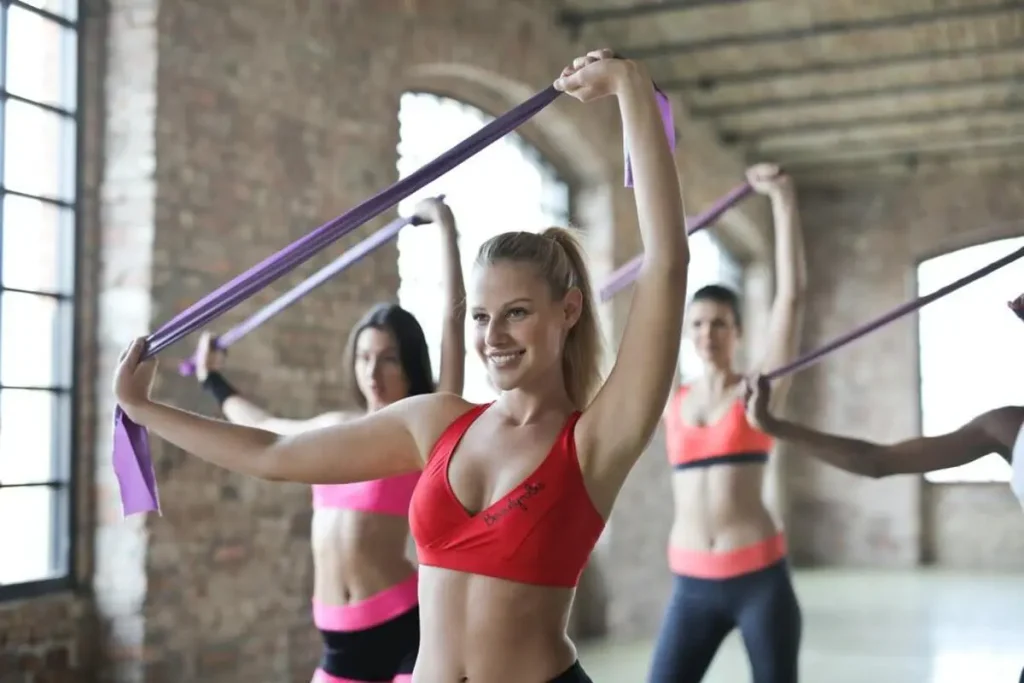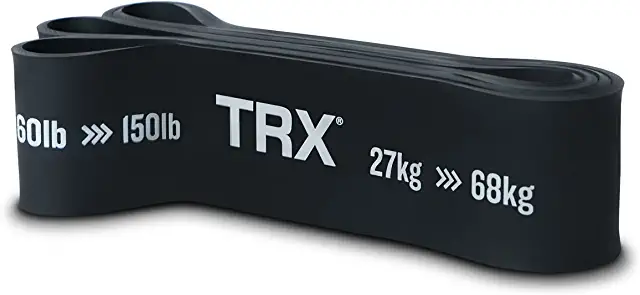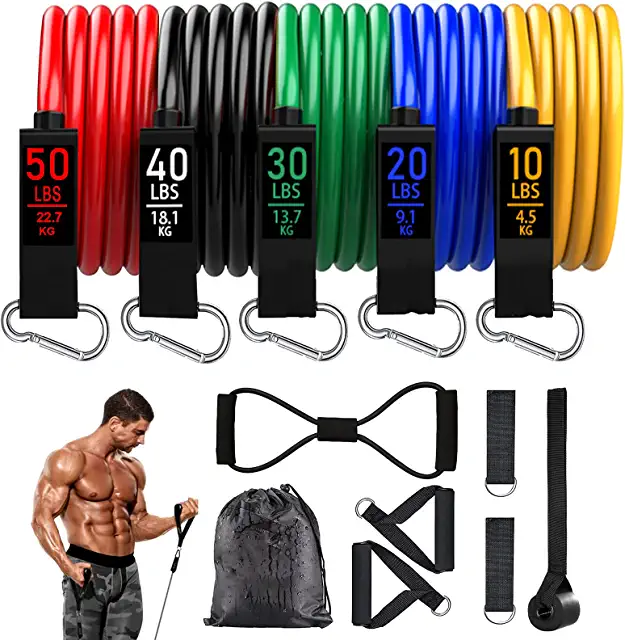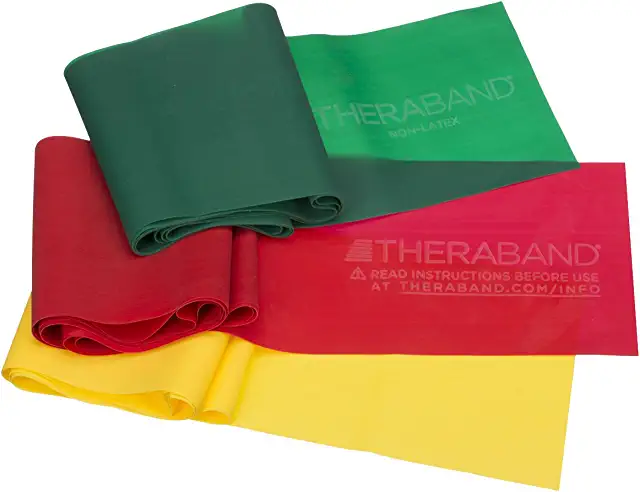I recently came across a stunning (and sad) metric: American adults – on average – only do 17 minutes of fitness activities per day. That’s just 2 hours of physical activity per week! And I thought I was lazy.
Anyways, those 2 hours per week are just half of the CDC-recommended physical activity levels for adults. And while the gym is a great investment, not everyone has the time or financial resources to join a fitness center. Likewise for a home gym; not everyone has the space or money or time to build one.

And this is what makes resistance band – or exercise band – training an ideal form of exercise. You can exercise virtually anytime and anywhere with minimal space requirements, and you can do so without breaking the bank. And you don’t need a personal trainer to get started.
Of course you can exercise without any weights, but if you’re looking for a full-body strength training workout that grows with you then consider resistance bands. This article discusses 12 benefits of resistance band training, so keep reading to learn more!
What Are Resistance Bands?
Resistance bands are rubbery bands – almost like stretchy cables – designed for strength training.
They come in various lengths, various strengths, and may be shaped as a loop, straight, flat, or tubular. Tubular resistance bands typically have handles on them. The types of resistance vary among bands with tension varying from light to extra-heavy.

Depending on the band type, they can with or without handles and have a wide variety of uses. Some people use them to aid in physical recovery, while other people use them as an effective part of their workout routine. Bands are also used to work on mobility and/or to make particular exercises easier or harder.
In terms of a workout routine, as you use your body to oppose the force of the resistance bands, you’re able to get a workout tailored to your fitness level. Be sure to choose a band that works best for you. You can anchor resistance bands in place and push, pull, and curl them, to name a few exercises.
In short, bands are very versatile and have a wide range of applications in health and fitness. And, as a bonus, they’re very affordable and take up minimal space.
Different Types of Resistance Bands
There are several types of resistance bands. The type of resistance band you purchase will depend on your personal goals. Let’s take a look at some common resistance bands.
Loop Bands (Power Resistance Bands)
Loop bands are like giant rubber bands. Loop bands are great for bodyweight exercises that require assistance. You can use them for pull-ups and dips, just to name a few.

Or, one of my personal favorites, you can also use loop bands for additional resistance. For example, you can use a band to add additional resistance or tension to the top part of a push-up. If you have a squat rack 1 and the know how you can even use them in traditional exercises like bench presses or deadlifts.
Tube Resistance Bands (Complete With Handles)
Tube resistance bands are another type of band to choose from. While the bands aren’t typically quite as strong as looped bands, they are pretty durable. They’re made to mimic certain gym machines and can also be used as a replacement – or addition to – dumbbells or barbells.

These types of bands typically come as a set with various types of attachments included.
And since they have handles, they’re great for pulling and pulling exercises such as chest presses, curls, back rows, and shoulder presses. Generally, when you see a resistance band workout online, it’ll be done with a tube type resistance band.
Resistance Bands for Light Therapy
These bands can be very long, rating up to 7 feet. They’re thin bands that don’t loop or connect to straps but are thin enough to tie into a knot.

Light therapy bands are perfect for anyone looking to regain strength following an injury, seniors looking for low-impact exercises, or with pilates or other light workouts. These are the type of bands you’ll see most often in physical therapy and aren’t really sufficiently strong or durable enough for a resistance band workout.
With that out of the way, let’s take a look at some of the benefits of resistance band training.
1. Improve Overall Flexibility
Resistance bands are part of a complete fitness plan. You can practice stretching or mobility with resistance bands, working to increase your flexibility. Think of them like a workout partner, helping you get deeper and deeper into your stretch.
You can use them as a stand-alone workout tool or incorporate them into your exercise routine, treating them as a warmup or cool-down activity. On a side note, you want do mobility work before your workout and save your stretching until after your workout.

2. Muscle Strengthening
Resistance bands are great for strengthening muscles. They work like free weights, helping your muscles resist and fight against the bands. And, in some ways, they are better than free weights in that you get maximum tension on the band (and your muscles) when the band is extended.

For example, let’s take a simple standing bicep curl. Once you overcome gravity and the weight, you lose tension at the very top of the curl. However, with a band, this is actually when you get maximum resistance on the band and your biceps.
And resistance is key when helping your muscles grow and get stronger. And while you can add a resistance band to your usual lifts – squats, leg lunges, overhead shoulder presses, tricep kickbacks, etc. – you can also use them in tandem with other forms of exercise.
In summary, resistance bands can help your muscles progress by adding additional tension and stimulus to your exercises.
3. Improve Balance
You can also effectively work unilaterally, which is just a fancy way of saying one side at a time. Working unilaterally allows to focus on and fix any muscular imbalances.
You can also work specific balance and stability exercises just using the bands. As these muscle groups and your coordination progress, so does your posture and stability.
4. Saves Money
Cheap resistance bands range from $10 to $20, so they remain relatively affordable. You’re able to get a myriad of exercises without breaking the bank. This is great for anyone on a budget who still wants to work out and improve their overall health.

Obviously, like anything else, you have more expensive options that provide better quality, more variability, and the similar upgrades.
5. Increases Brain Function
Working out – resistance training specifically – increases blood flow to your brain. Increased blood flow can alter the structure and function of your brain, assist in the creation of new brain cells, and releases endorphins.
As such, your mood and overall health is improved after working out.
6. Portability
Whether you travel for work or simply enjoy pilates in the park, resistance bands make for a wonderful traveling gym companion. Since resistance bands are small and light, you can take them anywhere.

If the hotel you’re staying at doesn’t have a gym, you can easily pack resistance bands in an overnight bag. Since they’re compact, you can use them in virtually any area for an instant workout, regardless of space.
7. Avoid Heavy Weight Lifting
Look, I love lifting heavy. And while lifting heavy is great for most, some people are just unable to do it. Not everyone can or even wants to throw 400 lbs. on a trap bar and deadlift.
This might be someone recovering from an injury, someone with back issues such as herniated discs, or someone with other health issues that would prevent them from lifting weights.
In those cases, resistance bands provide an effective alternative to weight training 2 always check with your doctor, blah blah blah. Now you can use bands with weights but they absolutely can be used by themselves as well.

The important thing is to just get some physical activity and just get started. Remember to start light and build from there.
8. Good For Injuries
If you’ve sustained an injury, resistance bands are excellent recovery tools. Most physical therapists use them for recovery. You can talk to your doctor or physical therapist about which color band (resistance) is best.
Resistance bands can help with sports-related injuries. They assist with increasing your range of motion while improving your strength and flexibility. Since they’re low impact, they don’t put unnecessary stress on the joints.
You can use resistance bands for the treatment of tennis elbow, knee injuries, dislocated or hurt shoulders, ankle sprains, and hip bursitis, to name a few.
9. Core Stabilization
If you’re looking for core stabilization exercises as part of a full-body workout, then look no further than resistance band workouts. Resistance bands are great for strengthening your core, aiding with stabilizing and mobilizing functions.

While you can work the core in a ton of different ways, banded movements can add an additional component that’s hard to simulate with other tools such as slam balls.
For example, a simple to execute Pallof Press is a great anti-rotation core exercise that can be done by almost everyone.
10. Improve Athletic Performance
Since traditional weights can’t provide the same type of resistance that bands do, they’re an essential part of any fitness routine. As they increase mobility and flexibility, you’ll notice you have increased power, agility, and speed. Theoretically, smart usage of a resistance band can translate into running and moving faster.
Basically, you can become a better overall athlete using bands.
11. Weight Loss
If you’re looking to lose some weight, then consider resistance bands. While you also need to focus on healthy eating habits, resistance bands can help burn calories and build muscle.

As you gain muscle, you’ll raise your base metabolic rate and you’ll have an easier time keeping weight off. This is because your body at rest will burn more calories, as muscle is metabolically more active than fat tissue.
For example, 1 pound of muscle burns roughly 5-6 calories while 1 pound of fat burns roughly 1-2 calories per hour. That means in one day, on average, 1lb of muscle will burn an extra 96 extra calories in comparison to fat tissue!

12. Reduce Back Pain
Almost 80% of Americans have some type of back pain. Resistance bands – and exercise in general – are an excellent way of reducing this back pain.
When used correctly, they can work the muscles in your core, back, and hips. Remember, everything is connected and while you may have back pain, the cause of that pain could be elsewhere.
While entire books have been written on back pain, it’s safe to say that the stronger your core muscles are the less chance of back pain or reinjury. As your flexibility and stability increase, you’ll naturally improve the strength in your lower back muscles.
Be sure to focus on your form when using a resistance band. When used correctly, they can eliminate jolted, erratic movements that are commonly seen when using free weights, providing a more stable exercise routine.
Resistance Band Training Summary
Now that you know the benefits of resistance band training, you have no reason not start! 3unless you’re lazy, that’s always a reason. Resistance band workouts are a great way to tone up, build muscle, and get in shape while having fun. Not only that but resistance band exercises can grow with you as you progress with your fitness routine.

If you’re recovering from any type of injury, such as a shoulder injury, a resistance band can help with your road to recovery. The important thing – no matter how or even if you use a resistance band – is to just get started exercising.
For more great articles about exercise and nutrition, be sure to check out the rest of our blog, reviews, and other great information. Happy training!







